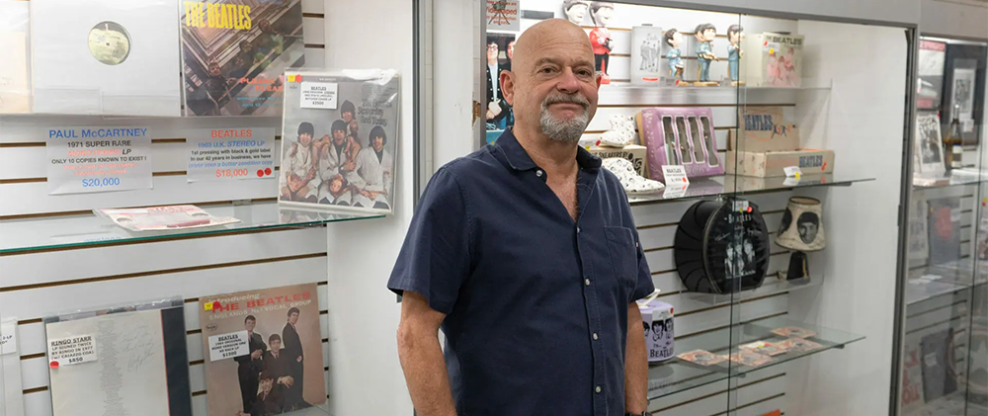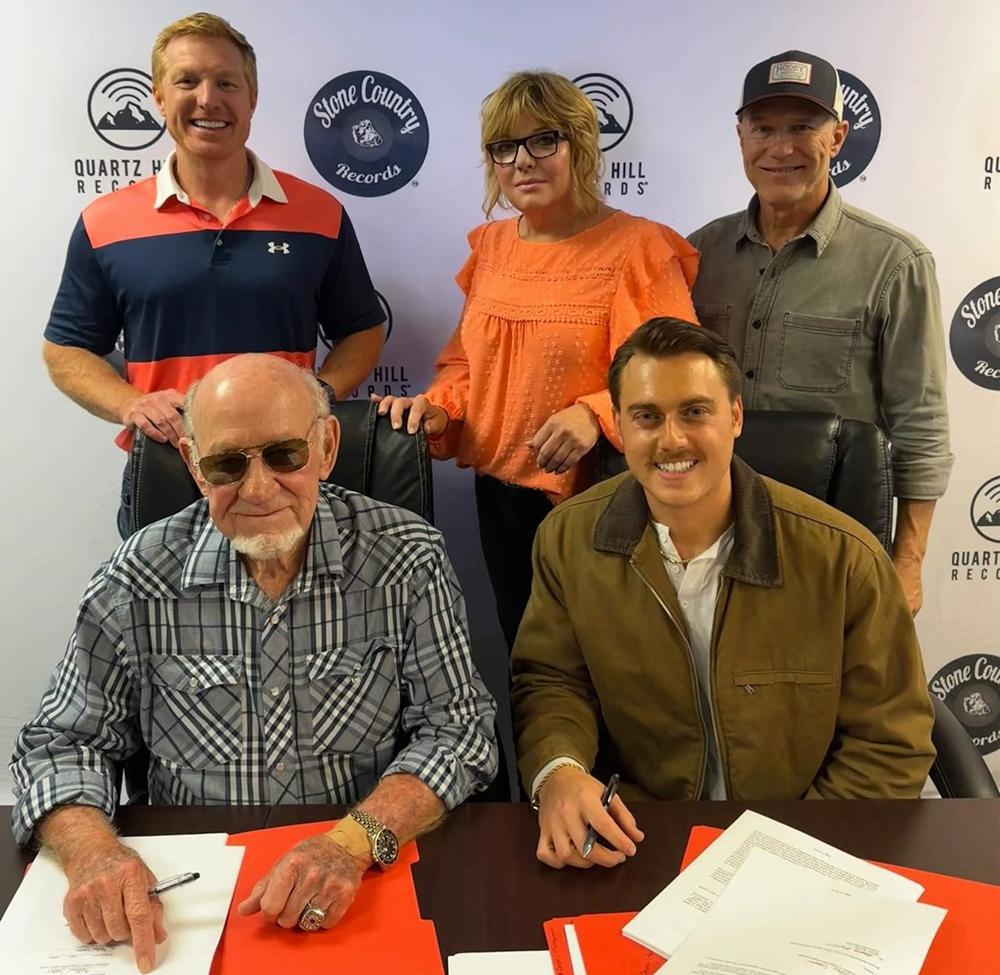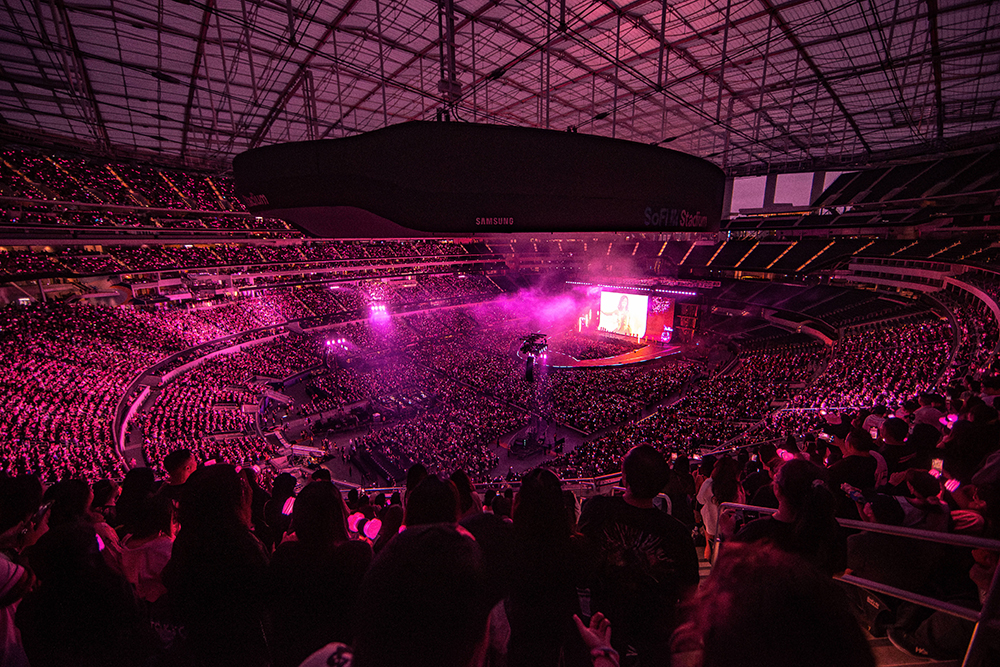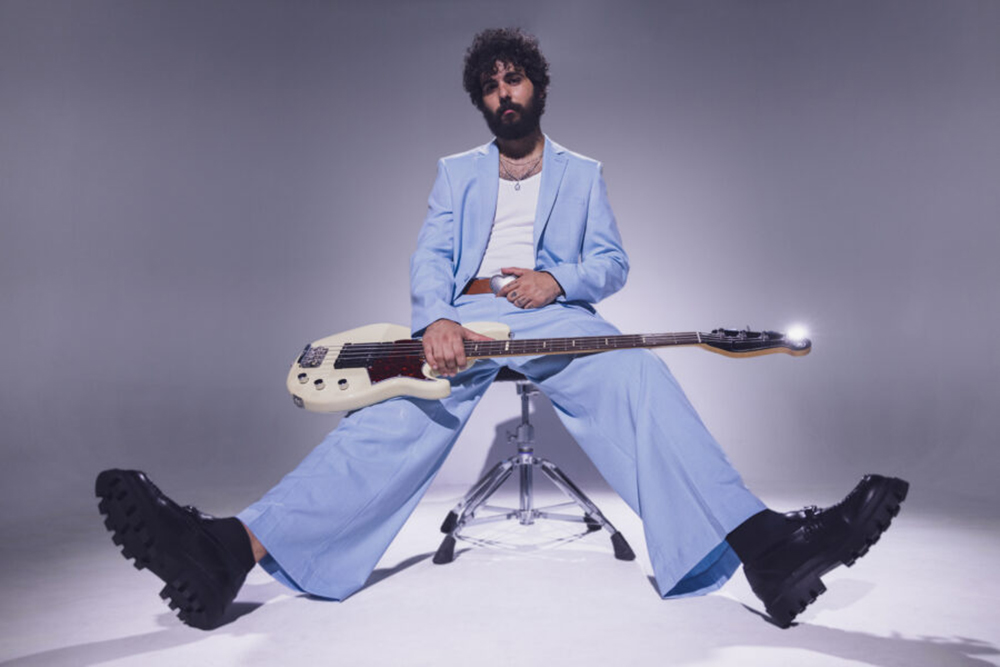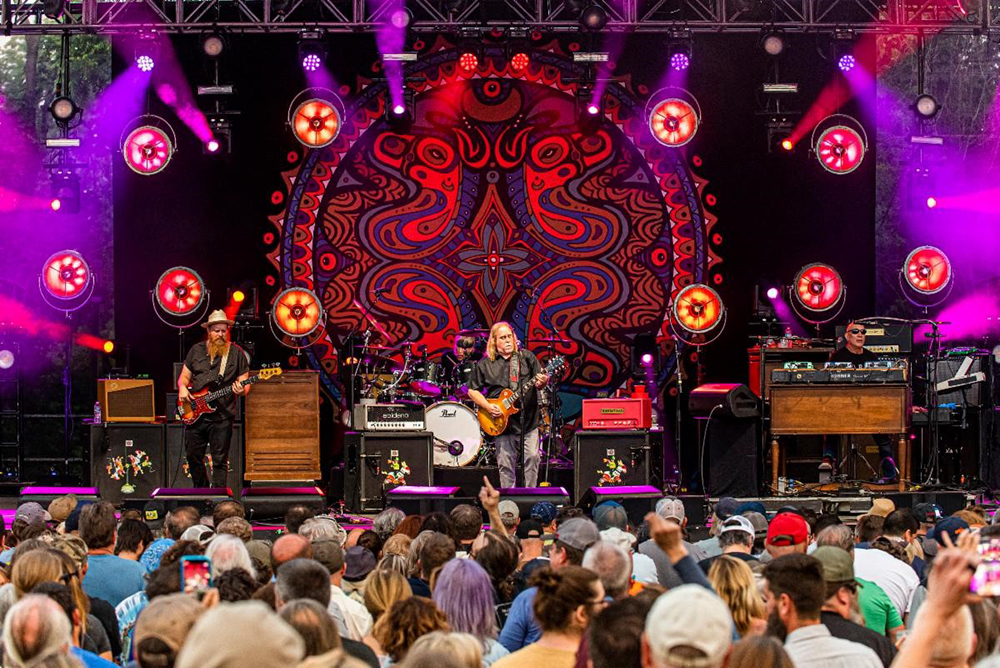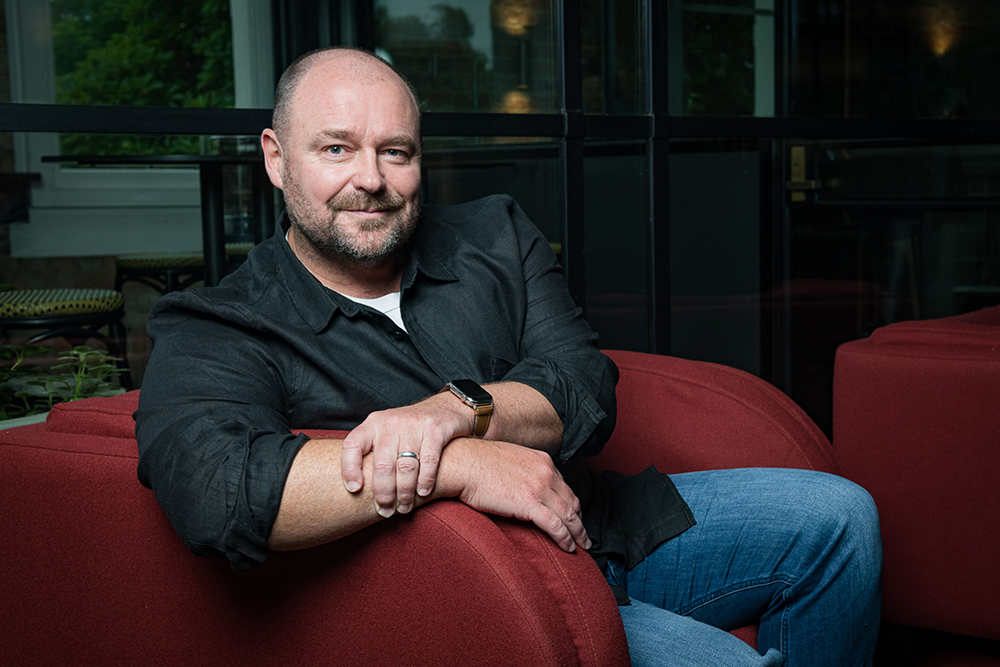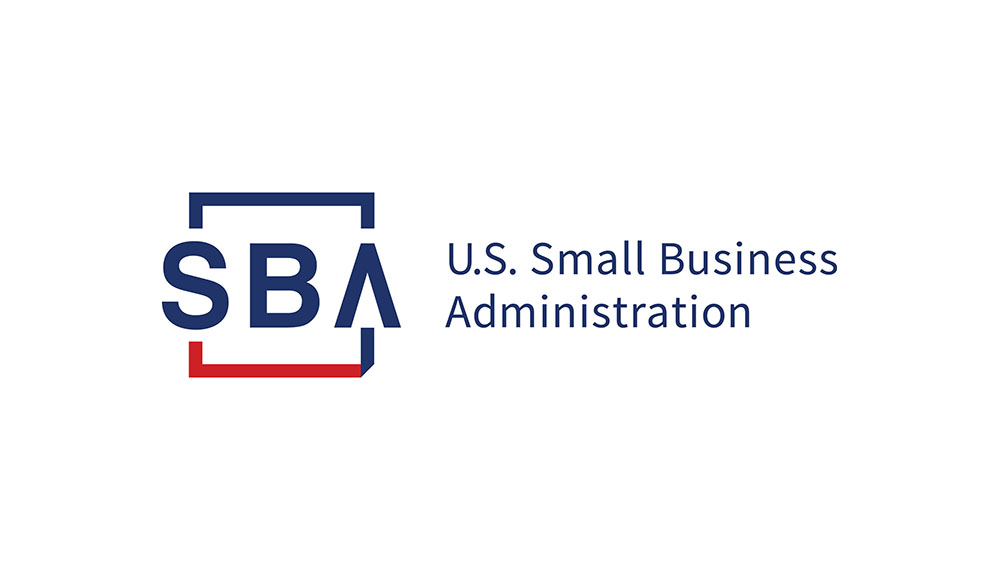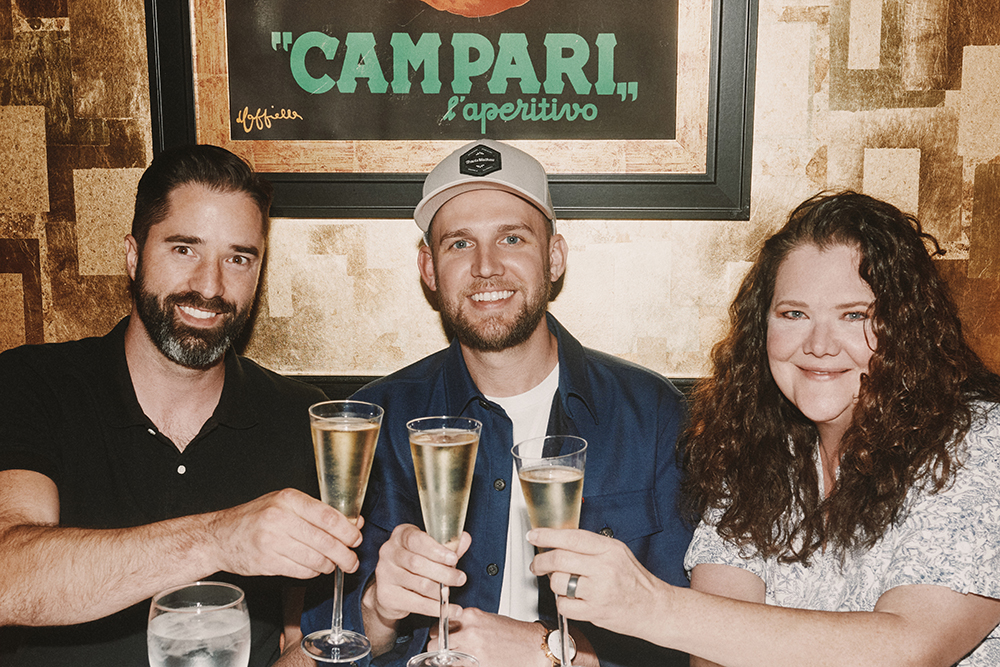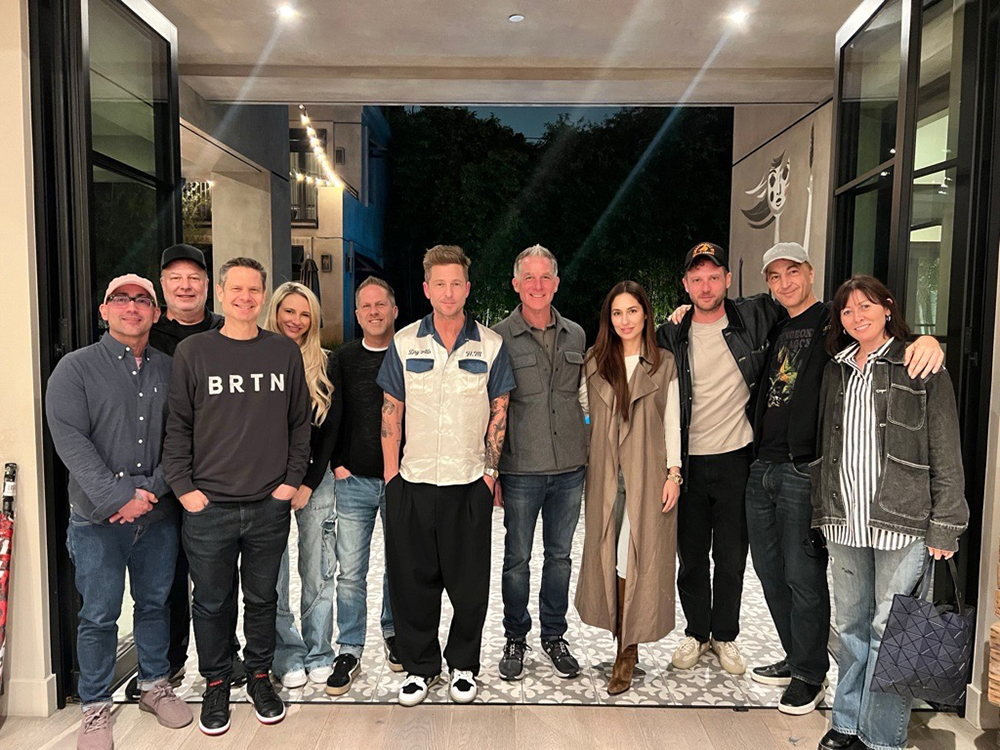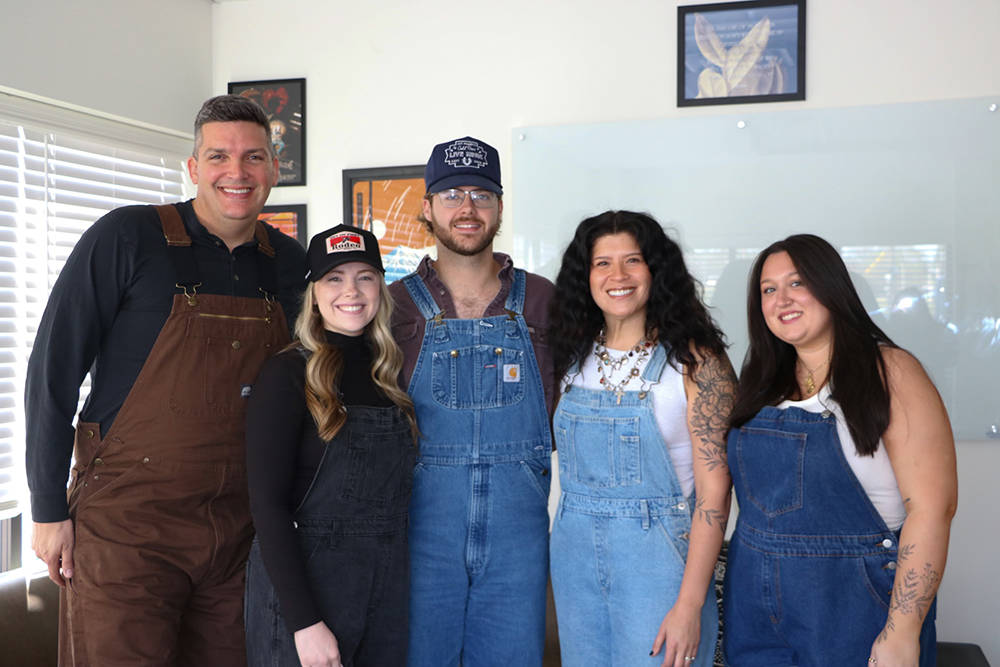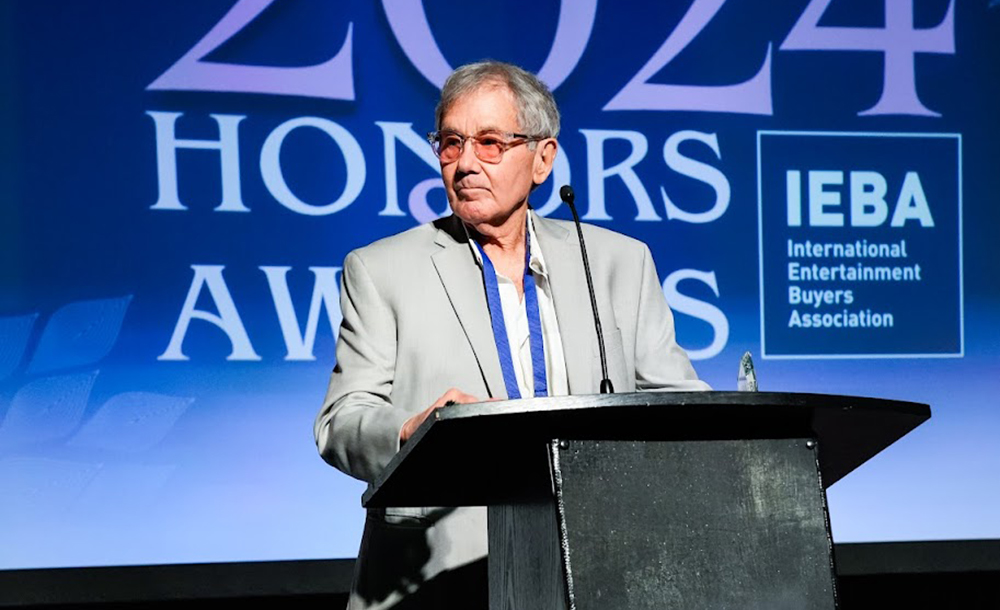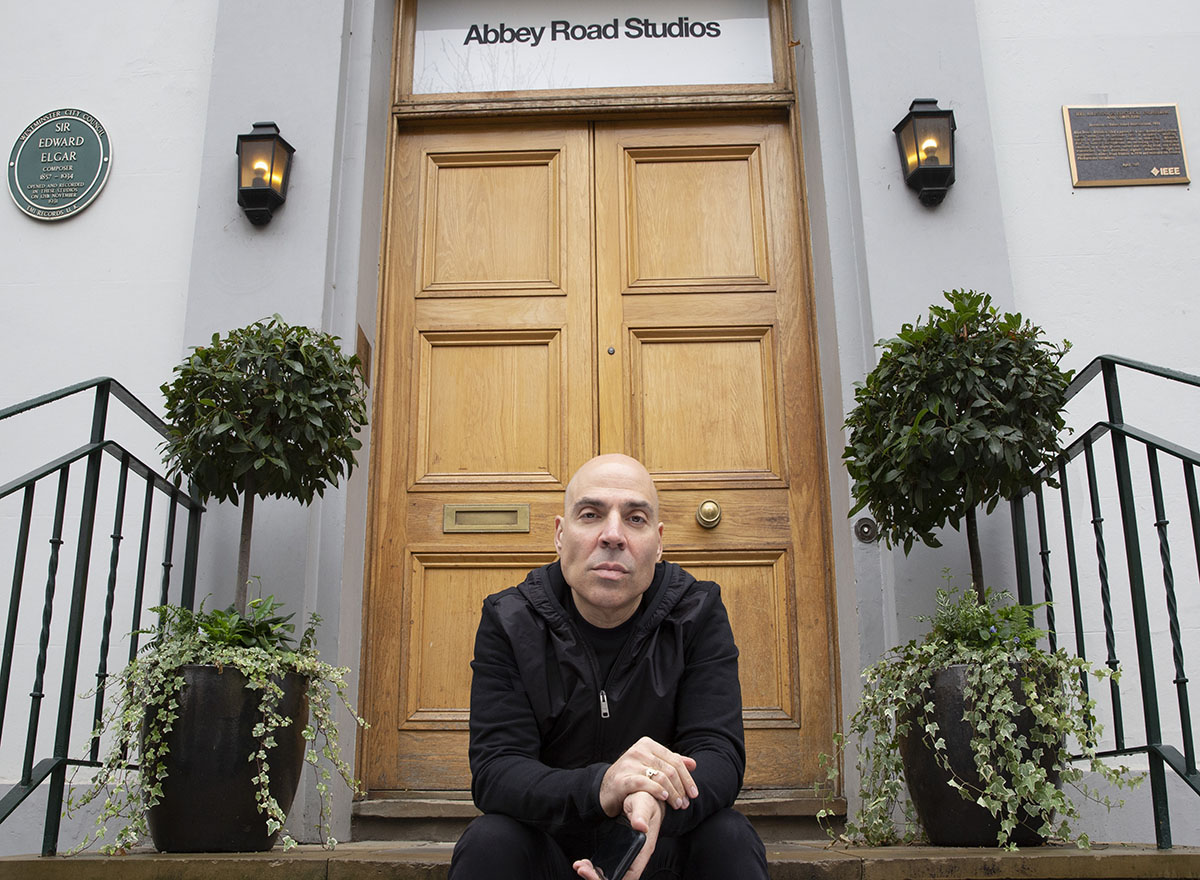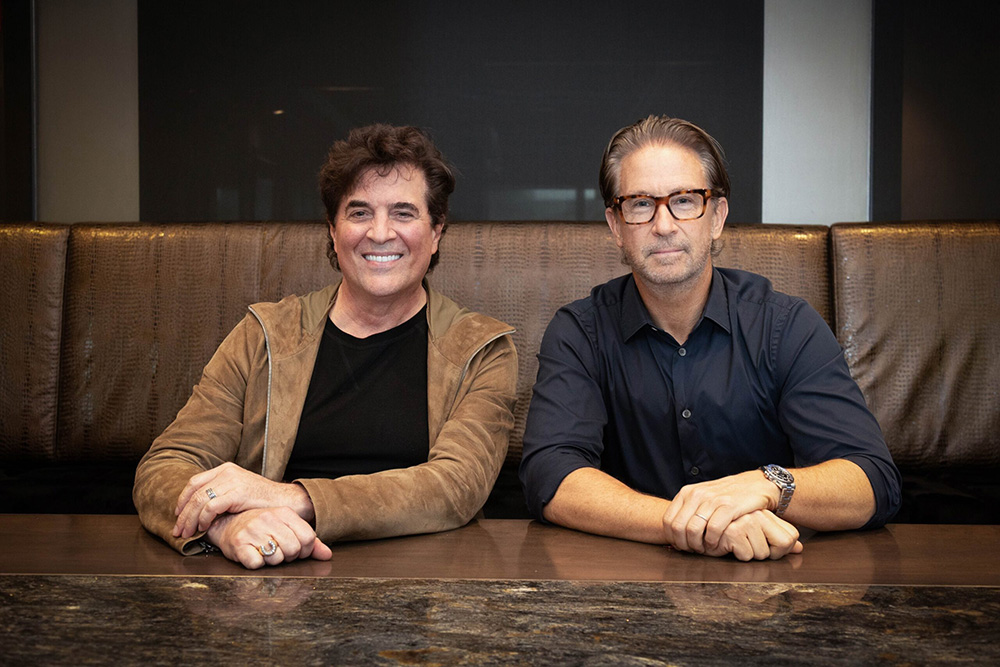This week In the Hot Seat with Larry LeBlanc: Wayne Johnson, president, Rockaway Records.
While vinyl recordings, once on the verge of being relegated to history’s technological junk bin, have become one of the music industry’s biggest comeback stories, it’s also evident that music memorabilia and collectibles sales are also now skyrocketing.
As a result, after a complete two-month shut-down, Rockaway Records in the Silver Lake area of Los Angeles, last year shifted from being a brick-and-mortar music Mecca to an appointment-only shop.
Co-founders and brothers Wayne (president/memorabilia buyer) and Gary (VP/vinyl buyer) expanded their high-end music memorabilia business, stocked up even more on highly sought-after vintage vinyl, and collectibles, and reopened their famed record shop of 40 years, but no longer accepted walk-in traffic.
A potential buyer needs to be in contact in advance, and make an appointment. Call 323-664-3232; Email info@rockaway.com.
While nearly every other independent record store and many chain outlets in Los Angeles have forever shut down, Rockaway has managed to stay open bolstered by the Johnson brothers traveling the world, acquiring and selling music collectibles.
Two years ago, during COVID’s earliest days, collectible prices soared as many people migrated to online music buying for the first time. Over time, with independent record stores firmly closed except for mail order, people discovered music collector sites and started purchasing at a frenetic rate.
Much of the collectibles and rare vinyl market today skew to the young, Gen Xers, and millennials largely interested in bands like the Sex Pistols, Black Flag, Joy Division, Nirvana, Pearl Jam, Sonic Youth, Beastie Boys, and Jane’s Addiction as well as the Rolling Stones, and the Beatles.
Rockaway has continued aggressively acquiring extensive record industry and personal collections of vinyl as well as concert-related items, tour programs, promo items, and varied rarities.
The Johnsons are known to frequently pay five to six figures for valuable collections.
The two siblings began re-selling albums in 1979 after attending one of the legendary record swap meets at the Capitol Records parking lot in Hollywood. What began as a hobby quickly turned into a business when they opened their own Rockaway Records store, and soon afterward purchased Rainbow Records, a small well-known record store in the Silver Lake area of Los Angeles.
Rockaway grew so quickly that it moved locations several times, finally settling into the present Silver Lake store in 1992.
To visit you these days at the store I have to make an appointment?
Oh exactly, yeah. We’ve gone from 50 to 60 customers a day before COVID to about 5 or 6 customers a day, and sales are better than they have been in 30 years.
In Los Angeles, one after another of the independent music retail stores disappeared over the years as musical formats changed from vinyl and cassettes to CDs, and to downloads, and streaming, and now back to vinyl, collectibles, and high-end memorabilia at retail.
How did you manage to flourish through 40 years?
By changing. By constantly changing with the times. This business has changed so frequently. The transition from CDs to vinyl, and then CDs were phasing out, and then back to vinyl. We were always a step ahead of the changes or we were constantly watching, and changing where a lot of my competitors just refused to change. That’s the kiss of death in this business, especially today because everything changes so fast.
Last year, you shifted to an “appointment only” concept while vastly expanding your music memorabilia offerings. A lot of the product you had been selling was CDs. You weren’t making a great deal of money, and it was taking your staff too much time dealing with inventory, stocking, and other retail issues.
Oh exactly. We had way too much stuff, and room. And worse than the cheap vinyl were the cheap CDs. The average price of a CD was $3. We sold tons of them, but it wasn’t worth the labor.
I think where many independent retailers went wrong was in opening up affiliated record labels as well.
That’s a whole other ballgame that I wouldn’t even think about getting into. We had a good diversity of everything for the longest time. We kind of catered to all music lovers. That is why I kept selling $3 CDs as well as $10,000 and $20,000 records. We had something for everybody which people loved. And to be honest with you, before COVID, I knew that we were wasting a lot of overhead on the cheaper stuff. I knew it, but I couldn’t bear to disappoint my customers. But COVID forced me to consider making a change. Then I realized how much of a difference that it made, and I had to face that I couldn’t keep going on that way.
I was recently in New York to see Cameron Crowe’s “Almost Famous” musical, and while in Manhattan, I always go past where the Colony Record store was at 1619 Broadway. It breaks my heart looking at the storefront now. The Colony Record store closed in 2012 after 64 years following its landlord announcing plans to jack up the monthly rent from around $1 million to as much as $5 million.
The Colony Record store was first located at Broadway and West 52nd Street, but in 1970, it moved to the corner of West 49th Street and Broadway, where its neon signs, and windows full of sheet music became a beacon for all music lovers.
As Liz Woolman wrote in a blog published by Oxford University Press: “The largest and easily most famous provider of sheet music in New York City, Colony also houses cassettes, CDs, DVDs, karaoke recordings, an absolutely enormous collection of records, and all kinds of memorabilia, pop music action figures and Beatles mousepads; signed, fading photographs of A-, B-, and C-list celebrities from every decade that the store has been open; novelty key chains and promotional buttons from countless Broadway musicals; old concert programs, playbills, and T-shirts; Ramones coffee mugs, and ‘Glee’ lunchboxes; and locked shrines in dank corners, filled with dusty Frank Sinatra, Marilyn Monroe, and Elvis Presley collectibles.”
How co-owners Michael Grossbardt and Richard Turk, whose fathers, Harold S. “Nappy” Grossbardt, and Sidney Turk started the store in 1948 as partners, ever got out of that space with all of the product that was there– more than one million vinyl records, and sheet music from virtually every Broadway show and film ever made—is beyond me.
I knew Alan Grossbard as well. He had some amazing stuff. I don’t know if you noticed but he priced everything so high that he wouldn’t close sales. Everything was faded. Much of what he had was ruined because it was faded by the light. It sat there for years.
The good stuff was in the basement.
Right, which he has been selling on eBay. I haven’t talked to him in 5 years or more, but he was selling what he had left on eBay. He might be out of it now. I have no idea.
A resurgence in vinyl began about 12 years ago, it just seems to be exploding ever since. I’m just seeing people spending up to $1,000 for new special edition vinyl releases. At the same time prices on vinyl from 1995 to 2005 have skyrocketed. Those were the years when the record companies scaled back pressings with the advent of downloads, and streaming.
What qualities drive up the value of a vinyl recording? Name value, and quality obviously and of course, how many first-generation master recordings were issued. What else?
Demand. How collectible an artist is. The big thing today is condition. When we started 40 years ago, good condition to mint meant double to triple (pricing). Today, it could be 20 or 30 times the difference. Everybody wants mint stuff. It is basically following in all of the other fields of collectibles. Other collectibles have known for years how important condition is.
I’ve seen numerous collections of original vinyl still in the original shrink wrap. Not one record opened.
That’s the super valuable stuff. To give you an idea of how important condition is, take a “Meet The Beatles!” album in mono from 1964. What most people call pretty good condition, I sell for about $20. Mint $400 or $500 to $3,000 or $4,000. That’s the difference what condition is.
What stands up well is the Japanese Toshiba-EMI EAS series of the Beatles’ pressings of the 1970s. I’m blown away by the quality of the recordings and the quietness of the vinyl. These are considered by most collectors to be among the best sounding Beatles albums issued anywhere. Also impressive are the original UK Parlophone Beatles pressing.
Most people used to think that they were the best. Ten years ago the Japanese vinyl was going for good money. Now everyone says the UK pressings sound better and they are going up in price even way more.
The Brits put a lot more care into every aspect of music reproduction.
People love British vinyl. The price of British vinyl in the past 10 years has skyrocketed. Even common British albums. Like you take a U.S. Zombies’ “Odessey & Oracle,” you might get $100 for it. The UK version is $1,000.
A rock history irony is that the Zombies’ 1968 album “Odessey & Oracle” released wasn’t a hit until a year later and after the members had parted ways. Even then it only reached #95 on Billboard’s album chart while its single “Time of the Season” reached #3 on Billboard’s Hot 100. And neither charted in the UK.
First of all, the UK pressings weren’t as big (In size) as the U.S. pressings, obviously. And very few people in the UK took care of their records. It is really hard to find clean UK records from the late ‘60s and early ‘70s.
The first I heard of rock memorabilia being collectible was following Peter Morton and Isaac Tigrett opening the first Hard Rock Cafe in London in 1971. in 1979, Eric Clapton donated an un-signed Red Fender Lead II guitar. He wanted management to hang the guitar over his regular seat in the restaurant. After the Clapton donation, Hard Rock’s founders received a package that contained a black Gibson Les Paul, and a note that read “Mine’s as good as his. Love, Pete” from Pete Townshend. Since then rock artifacts have become the beating heart of the Hard Rock Hotels and Resorts, and Hard Rock Cafes brands globally.
That stuff was so cheap back in the day. We started in ’79. I wish I could go back in time and buy some of the stuff that we sold. A good example, one of the things that I wish I had from 1980 or 1981 is the Andy Warhol lithograph of Mick Jagger signed by both Warhol and Jagger. I couldn’t give it away at the time. I was asking $1,500 for it. I paid $800 for it. I had it for like a year. Nobody had any interest in it. Finally, somebody gave me $900 for it. So I got my money back. Do you know what that’s worth today?
Your local competition earlier was likely Delicious Vinyl, Licorice Pizza, Rhino Records, Atomic Records, and Amoeba Music.
As Quentin Tarantino put it, “I would say Amoeba is pretty good. I don’t know if I’d call them ‘the best in the world,’ but they’re pretty damn good for Los Angeles, I will say that.”
The new Amoeba Music location at 6200 Hollywood Blvd. opened on April 1st, 2021. The original Amoeba Hollywood was formerly situated at 6400 Sunset Blvd.
Increasingly, in focusing on vinyl, collectibles, and high-end memorabilia, your competition has become the Hard Rock Hotels and Resorts, and Hard Rock Cafes, and auction houses like Julien’s Auctions. in Culver City, Sotheby’s, and Christie’s which host auctions of major music figures.
As do such online sites as Backstage Auctions, Pristine Auctions, Rockstar Galley, and Analog.
All of these various online auction sites, that’s your competition.
You are absolutely right. They are competition, but what most people don’t realize is that, yes, you see these ridiculous prices on a few items that they get, but 90% of the items in their auctions I could pay upfront than what they end up with. Julien’s is a great example. A few years ago they had a belt buckle that was given to someone by John Lennon, and they listed it as “Belt Buckle, owned by John Lennon.” No big deal. And I knew all about it. I know you worked for Record World trade magazine. So you knew Spence Berland.
Oh yes, I knew Spence who died in 2017. As senior VP of Record World in the ‘70s, he ran our West Coast office. He was a master at selling ads for special “tributes” to artists, record companies executives, distributors, and rack jobbers. You name it. Spence knew all the greats, the near greats, and the greatest.
He was a good friend of mine too.
In 1974 John Lennon gave Spence a belt buckle.
Spence Berland often wore a rare RCA “Nipper” promotional belt buckle. John Lennon saw it and really wanted it. After several requests for Spence to let him have it, John ended up trading Spence his own 3.5″ x 2.25″ buckle (nickel/silver with 9 turquoise stones) for the RCA buckle. John also gave Spence a handwritten note in black marker which said, “To Spence Belt up! Love John Lennon ‘74.”
I knew about this belt buckle, but Julien’s, in my opinion, did a terrible job in listing it. I got it for $4,000, and got it away for $15,000. I would have paid Spence $10,000 if it had come to me. Instead, he ended up with about $2,500.
One of your strengths as a buyer is that you are aware of, and understand, the history of what is being offered for sale.
Exactly.
I do love Julien’s lavish catalogs.
Oh, yes.
They are worth up to $1,000. I have several. Julien’s specializes in entertainment memorabilia and celebrity estate auctions. Over the past 16 years, it has held auctions for the collections of U2, Cher, Madonna, Barbra Streisand, Michael Jackson, Alex, and Eddie Van Halen, Kurt Cobain, the Beatles, Bob Dylan, Jimi Hendrix, Prince, Elton John, and Little Richard. Julien’s deals with a lot of high-end memorabilia. I love Cher. But I don’t want to own anything of hers.
Yeah, the auction houses do good sometimes but, to be honest with you, they don’t do their homework right. We research everything and hate to say it, but there’s tons of stuff at the big auction houses that I believe is phony. Autographs, gold records, sealed albums. We are way pickier than they are. I don’t want to sell something unless I am absolutely certain that it is real. The auction houses just take too much stuff, and say, “Oh, this looks pretty good. We’ll take it.”
Music memorabilia is one of the best ways for fans to connect on a more personal level with their idols. It can also be an incredibly valuable asset with high-yield potential. Prices have risen not just for the rarest items, but also for pieces that might have been collecting dust in garages and attics. Many of those items make it onto consumer auction sites like eBay, while others are put up for bidding by auction houses or sites.
People look at the prices of music memorabilia —everything from tour posters to lithos to T-shirts, autographs and albums, clothes—and they’ll say, “This stuff is so expensive” to purchase. I got news for them. Music memorabilia is cheap compared to say sports memorabilia.
I would say exactly the same thing.
Game-worn jerseys have had a banner year on the auction block in a market that has grown exponentially more lucrative in recent years.
The blue kit worn by the late Argentine soccer legend Diego Maradona when he scored his unforgettable “Hand of God” goal during the quarterfinal match of the 1986 World Cup against England fetched $9.3 million in an online Sotheby’s sale in May (2022), then setting a new high-water mark for sports memorabilia.
Five months later the record was surpassed by Sotheby’s when the jersey Michael Jordan wore during Game 1 of the 1998 NBA Finals sold for $10.1 million.
A mint condition Mickey Mantle 1952 Topps baseball card sold in August (2022) for $12.6 million. It surpassed the $7.25 million for a century-old Honus Wagner baseball card sold earlier in a private sale. There’s also the Luka Doncic rookie card, and the LeBron James rookie card which were sold for $4.6 million and $5.2 million respectively.
The card trading market has grown even more lucrative of late.
I’ve been saying exactly the same thing. When I see a baseball card selling for $12.6 million and even worse than that–sports is important—but what gets me is that a Pokémon card sold for $1 million. Is that ridiculous or what?
There is only one known PSA grade 10 Pikachu Illustrator card in the world, according to Guinness Book of World Records. In 2021, podcaster, actor, and professional WWE wrestler Logan Paul purchased a PSA grade 9 Pikachu Illustrator card for $1.275 million. He traded this card, along with $4 million, to obtain the PSA grade 10 card he now owns which is said to be worth $5,275,000. The sale was acknowledged by Guinness World Records as the most expensive Pokémon trading card sold in a private sale.
A graded 9.5 Pokémon Illustrator card, valued at more than $1 million, is owned by New Raiders’ linebacker Blake Martinez.
Another industry with an insane resell market is video games including rare PlayStation 2 and Playstation 3 games, consoles, and accessories. Among the leading video game collectibles are Street Fighter statues, Mortal Kombat, and Marvel Games figures as well as heroes from modern hits like The Witcher and The Last of Us to classics like The Legend of Zelda, and Sonic the Hedgehog,
I know. All this rock and roll stuff is a bargain. People are going to look back in a few years and say, “I wish that I had bought that.” Some things are starting to go up. It’s good to see. Are you familiar with the Rolling Stones “Street Fighting Man” picture sleeve? I sold my first one in ’82 for $1,600, which was probably a world record for a 45 at that time. A few years ago, I sold one for $15,000, and it sold really quickly. I got another one in, and that sold for $20,000. Then just recently I heard someone got $80,000 for one.
It’s definitely the rarest Rolling Stones’ picture sleeve, and one of the rarest picture sleeves of all, very, very desirable, but that’s a big jump.
I’m not sure if that $80,000 was a fluke or if that is the new price, but I am hoping it’s the new price because it deserves it. One of the rarest picture sleeves in the world by one of the most collectible bands. Eighty grand is petty cash in the sports market. A wrecked Honus Wagner baseball card is worth $2 million. That’s crazy.
In late August 1968, just before the Chicago Democratic National Convention, where riots broke out between demonstrators and the Chicago police force, the Rolling Stones released “Street Fighting Man” as the lead single for the unreleased “Beggars Banquet” album.
“Street Fighting Man” was the follow-up to “Jumpin’ Jack Flash” which had been a worldwide hit.
This was the first picture sleeve released by the Stones that did not feature an image of the band. The picture sleeve used two images depicting police brutality taken from one of the many riots that had broken out in over 100 American cities earlier that year. Decca deemed the sleeve to be inappropriate, and it was immediately withdrawn. No one knows for sure how many sleeves survived, but many collectors estimate the number to be between 10 and 18 copies.
How did you come to oversee the sale offering of a 16″ x 48″ plastic piece of The Ed Sullivan Theater moveable wall signed by all four Beatles before they went onstage for their second set on Feb. 9th, 1964 at the request of stagehand Jerry Gort? All four Beatles signed on the back of the wall and drew a caricature next to each autograph.
First of all, I don’t own it, and I wasn’t able to sell it. So the consigner has it back. After the ’65 Ed Sullivan Show season, they were tearing down the whole stage and throwing away the backdrop. One of the workers there knew a handicapped Beatle fan (Lofton Sproles), “I know somebody who is going to like this.” So he cut it out and gave it to him. Then years later (in the mid-80s) he sold it to the owner of a bar in Baton Rouge (Rodney Cary of the Southdowns Lounge), and It was up on display for years. Then I think Frank Caiazzo bought it. He’s a leading Beatle collector, and he sold it to a local collector here in L.A.—a good customer, a good friend of mine; we go back 25 years ago—I think it was 50 or 100 grand. We turned down two offers of half a million for it. He wanted at least $600,000 for himself. So it wasn’t enough. He decided to keep it. I think he was smart to do that because that thing is the most important piece of rock history.
That section of wall should be in a museum.
Yeah. One day it is going to sell for millions. I have no doubt. I told him, “Don’t give it away.” So he’s sitting on it for now. It’s an incredible, incredible piece. I tried to sell it, and I had it for a while. Lots of people wanted it but nobody wanted to go more than $550,000.
On the other hand, due to the advent of eCommerce music memorabilia trading platforms, the entertainment marketplace is teeming with fake memorabilia. The risk of purchasing forged music memorabilia has grown in recent years. Three years ago, I was in a Las Vegas shop selling music memorabilia that the clerk claimed was authentic. I walked through the store saying, “This is phony. This is phony. So is that.”
They are phony. Practically every shop in Vegas has nothing but phony autographs. They have Beatles’ autographs for $10,000 that I could sell in a second for $100,000 if they were real. Why would they be selling a real autograph for $10,000? It doesn’t make sense.
Autographs that sold two years ago for $50 have jumped to $200 now. And many previously $200 autographs are now going for $500 or more.
Artists are making tons of money just signing things. That’s why a lot of artists refuse to sign now. They know what things are worth. The autograph market is another market that has skyrocketed in the last few years. A lot of prices have tripled in the past few years.
You and I have both worked in music for decades so we have a very good idea of what is real and what isn’t real, but it is easy to be fooled.
Right. But some times it’s difficult though. It’s not that easy to tell. The forgers for autographs are so good that I will be honest with you. I have been in this for over 40 years, and I cannot tell phony Beatles autographs. The forgers are so good. Luckily we are good friends with the leading Beatle authenticator in the world (Frank Caiazzo). I wouldn’t buy anything without his authentication.
The emergence of COVID led to Rockaway attracting more diverse buyers. First timers discovered your website. Buyers who couldn’t or wouldn’t shop because they were nervous about leaving their houses.
You are absolutely right. It turned music lovers into collectors. Pre-COVID, there were a lot of popular artists that I would never consider collectible. Katy Perry for one. She’s hugely successful, obviously but I never had people asking for her stuff. After COVID, her stuff is selling great.
Anyone from this period that might be collectible in a few years?
It’s hard to say, but I’m guessing people like Ed Sheeran, and Taylor Swift. They are important artists of today. Who else? To be honest I don’t keep up with the new music as much as I should. I grew up in the ‘60s. There isn’t too much music coming out today that I love, unfortunately. I try to listen to it, but I still love my ‘60s and ‘70s stuff.
So, Taylor Swift is collectible?
Oh exactly. It seems that any popular artist today is collectible as well. If they are popular they are going to be collectible. The world of collectibles has changed drastically. Not just because of COVID, but all of this limited edition vinyl.
In many cases, the reissued limited vinyl sets with additional tracks are used by artists to establish a new copyright.
That’s part of it, but the thing is when a new vinyl comes out of any artist who is halfway collectible, they don’t make one version they make 6 versions, and the collectors have to have them all.
That was the case with EPs in the late ‘70s and ‘80s that featured unreleased tracks, especially with those EPs released in the UK.
Yes, but not to this extreme. The last Paul McCartney album, “McCartney III” (2020) —I love Paul McCartney he’s my #2 guy, but his last album was awful. Yet, they made 6 different colored vinyl versions, and one of them sells for $2,000. It’s the one that Third Man Store put out. They only did 333 copies. “McCartney III” yellow vinyl with black spots.
This special McCartney edition went on sale October 21st, 2020, prior to the official announcement of “McCartney III“. Considering the very low number of copies, it sold out within minutes, and prices then skyrocketed on eBay days after. Third Man Records also manufactured a Red Edition limited edition of 3,000 copies.
Major labels, including Warner Bros. Records, CBS, and Mercury released limited edition live promotional recordings to radio in the ‘70s and ’80s. Are those original vinyl albums worth much today?
The better artists are. They are fairly common because Warner Bros. always did a lot of promos. The common artists are the less collectible ones and are probably worth less today than they were back in the day. But the U2 ones sell very well and there are a few others. Real collectible artists sell well.
There were also a slew of syndicated radio shows in the ‘70s and ‘80s that featured concert performances by leading rock and country recording artists. The two leaders were The King Biscuit Flower Hour, an American syndicated radio show presented by the D.I.R. Radio Network, and Westwood One along with Rockline Radio, Pulsebeat Productions, BBC Rock Radio, and “Innerview,” hosted by Jim Ladd.
Those are good because they are live shows. The interview radio shows have probably dropped in value. I used to do a ton of business with radio shows in the ‘80s. Westwood One was here in L.A. The radio show market was huge. Today, it’s the better ones that have gone up in value. The common ones have dropped in value.
It’s the same with most promos.
Everybody thinks that promo CDs, and promo vinyl are always going to keep going up in price. Not the case. I will give you a good example. Remember the first Beatles’ promo CD “Free As A Bird”? When that came out (in 1995), the first month I probably sold 100 copies for $40 a piece. Today, it’s worth about $2 if you are lucky. The record companies made so many of most promos, especially Warner Bros. Warner Bros. was probably the worst. Everybody at Warner Bros. knew the collectors market so they had extras, and gave them to their buddies and friends. Most of the promo stuff is not too valuable. Certain labels are. Columbia was less generous with their promos so some of the Michael Jackson CDs sell for hundreds of dollars because they didn’t make thousands of them. They made a few hundred of them. Big, big difference.
The UK BBC releases, those are quite valuable because they were very, very limited.
What about bootleg releases from The Amazing Kornyphone Record Label, The Swingin’ Pig, Yellow Dog Records, and Trademark of Quality? Their popularity exploded following Bob Dylan’s 1969 album “Great White Wonder,” a compilation of studio outtakes and demos; and the Rolling Stones’ “Live’r Than You’ll Ever Be,” an audience recording of a late 1969 show that received a positive review in Rolling Stone.
Trademark Quality is the best. Very very collectible especially the ones on colored vinyl. The prices of the bootlegs today don’t depend so much on the quality (of the recording). It depends more on the color. People love the colored vinyl ones, especially the marbled color ones. I sold some early Trademark bootlegs for as much as $2,000.
In the ‘80s, labels like A&M and Columbia, as well as Mobile Fidelity Sound Lab, released remastered versions of popular albums, using half-speed mastering from the original analog master tapes without compression, and with minimal equalization. The recordings were pressed in Japan using a plastic compound, invented by JVC,
Mobile Fidelity, yes. That market is really strong for those recordings. That is one of the few areas that has remained strong. The vinyl is great, and even the CDs sell, whereas 99% of the CDs out there are practically worthless.
Why is that? For the first 5 years of CDs there wasn’t much of improvement. For older releases, labels just used a copy of the analog master with limited enhancement.
That’s correct. But besides that, there is a big difference between CDs and vinyl. I probably reject 90% to 95% of the vinyl that is offered to me because of the condition. The condition is just not good enough. CDs are the opposite. 90% to 95% of the CDs out there are brand new or you just change the jewel case and you have a brand new CD. People took care of their CDs. So there is such a glut of CDs out there.
I would imagine that 8-tracks and cassettes aren’t highly valued unless it is something extraordinary.
Exactly. I sold a cassette for $7,000 not too long ago but it was the original “Black” album (by Prince) that got scrapped in the ‘80s, and it was the only known copy on cassette. So that’s why.
“The Black Album” was abandoned shortly before its intended release in 1987. Prince recalled all copies and abandoned the project. Almost immediately the album emerged in bootleg form. An original copy of Prince’s “The Black Album” sold for $27,500 in 2018, the high mark for any record sold on the Discogs site at the time. That album had been rescued from a pressing that was ordered to be destroyed.
How about ‘70s and ‘80s TV compilations released on album, tape and 8 track By K-Tel, Ronco, Arcade, TeeVee, Warwick, and Telstar?
Various artist records, in general, have very little value.
How old are you and your brother?
I’m 69. Gary is 63.
You and Gary began re-selling albums in 1979 after attending one of the legendary monthly record swap meets in the parking lot of Capitol Records in Hollywood?
That’s what made our business. That changed my life. It just opened my eyes. Before the Capitol Swap Meet I was a music lover since I was 10 years old, but I had no idea that used records had any value. I just assumed that they were worthless
Everyone on the planet went to the Capitol meets. That’s what you did. Even if you didn’t need anything you would go to see what everybody else was doing or go to talk to people. It was great thing while it lasted.It just opened my eyes. My brother and I started going to garage sales, and swap meets the week after.
In the ‘70s heyday of the Capitol Record Swap Meet, vendors ranged from those selling cheap, used LP’s from the trunks of their cars to those that set up makeshift stores to sell all sorts of rare records and memorabilia.
By 1980, the meet was moved indoors to various locations and bootlegs were banned. None of the indoor locations captured the spirit of the original.
What began as a hobby turned into a business when you and Gary opened up a Rockaway store, and then purchased Rainbow Records, a small well-known record store in the Silver Lake area of Los Angeles.
In those days expensive records were $50 to $100. There weren’t too many records worth more than $100 back in 1979.
UK and European imports were prized back then. Brit groups like Siouxsie and the Banshees, Generation X, and the Sex Pistols.
The Sex Pistols were like gold.
A “God Save The Queen” single on the A&M label, from a batch supposedly destroyed after the group left the label, sold for $15,882 in 2018.
The Sex Pistols originally signed to A&M Records UK in 1977. After an intoxicated altercation in the label’s offices following the signing, the band’s contract was reportedly shredded after only 6 days. A&M Records UK had pressed 25,000 copies of “God Save The Queen” in May 1977, but today only a handful are said to exist. For that reason, it is considered one of the rarest rock records of all time.
That’s worth a minimum of $10,000. Maybe more. It goes for as much as $18,000.
Rare punk pressings and singles now sell for thousands of dollars, and the demand for classic punk artifacts is higher than ever.
Tell me about the classic punk collection of rare vinyl, concert posters, T-shirts and clothing, memorabilia, and unique industry promotional items that you acquired last year, including items from the Sex Pistols, Black Flag, Fear, the Germs, the Misfits, Social Distortion, and others.
The Sex Pistols is the most valuable stuff in there.
When did you make the purchase from the local collector who wishes to remain anonymous?
Early in 2022. There’s a funny story about that. We started buying it 12 years ago. The guy brought in the first tray of 45s, letters A and B, and it was really good stuff. We said, “We definitely want the other letters when you are ready.” And early last year, 12 years later, my brother got an email saying that he was ready to sell the collection We bought everything, and it was definitely the most amazing punk collection. The good stuff, it just flew. I didn’t even have to advertise it. Word got out that we had it and people would come over and spend tens of thousands of dollars on punk 45s.
The Misfits’ single “Cough / Cool” (1977) sold at $12,000 and “Bullet” (1978) sold for $10,000. The Sex Pistols “God Save The Queen” UK 7” 45 test pressing (in cracked condition) sold for $10,000. And there were tons of $500 to $2,000 records. There were T-shirts in there, and posters.
Do you have artists seeking copies of their own recordings? So many artists lend out recordings and then don’t have a backup copy.
One of my best customers is Jimmy Page. I met him at the Olympia Record Show in London about 8 years ago. I had a Led Zeppelin concert flier on display there from Pasadena in 1969. It was up for $300 or something. I was talking to a friend of mine, and then this guy comes up. I didn’t recognize him. “Can I look at that?” I handed it to him, and then I ignored him because I didn’t know who he was. He handed it back to me and walked away. My friend said, “You know who that was don’t you?” I said, “No.” He said, “It was Jimmy Page.” Then luckily Jimmy walked to the next stand, and said to the guy there who happened to be a good friend of mine, “Who’s the guy next to you? He has some great stuff.” So my friend brought Jimmy back and introduced him to me. So we talked a bit. He came by my stall three times that weekend to look at the flier, but he didn’t want to buy it. Finally, I said, “Here Jimmy take it.” After that we sort of became friends—I don’t know about friends—but we talked, and he became a good customer.
We are buried today in albums and singles which are reissued in various special colored vinyl editions or on super duper, uber-audiophile versions. Or special web exclusive sets. Or previously unreleased concert or studio recordings by popular artists
Will there be anything again like “Once Upon a Time in Shaolin,” released by Wu-Tang Clan? That was a limited single copy sold in an auction in 2015, and is considered the most expensive work of music ever sold.
The winning “Once Upon a Time in Shaolin” bidder was Martin Shkreli, CEO of Turing Pharmaceuticals, who paid an unspecified amount. In 2018. Following Shkreli’s conviction for securities fraud, a federal court seized assets belonging to him, including “Once Upon a Time in Shaolin.” In 2021, the US Department of Justice sold it to non-fungible token collector PleasrDAO for $4 million to cover Shkreli’s debts.
Bob Dylan just did that. He just sold a recording of “Blowing in the Wind.”
Yes, a one-off re-recording of “Blowin’ in the Wind” was sold by Christie’s in London in July for $1,800,354. The release, made in March 2021 with Dylan’s longtime collaborator T Bone Burnett, is the first studio recording of the song since Dylan wrote it in 1962.
There will almost certainly be further limited editions where only 5,000 copies of a recording are pressed. It’s a good way for an artist to raise money.
It’s crazy what these artists can make now by doing things like that.
Interestingly with established artists, this can be done outside of a label because the artist owns their own master, and often their own publishing.
Exactly.
I think the more pop the artist the less collectible.
Exactly right. There’s hardly anybody in easy-listening pop that is collectible except (Frank) Sinatra. Good Sinatra stuff does sell. I sold a Sinatra 8-track for $6,000 one time, but only two existed or something like that. It was a different version than the album that was released. I guess they destroyed them all. I think there like only two known copies. That was the only way that you could get that version.
What put me off buying vinyl was that sellers would pull out data sourced from Goldmine or Jerry Osborne Record Album Price Guide or from Record Collector. I’d try to buy something in a small out of the way store I knew was worth $15, and the dealer would insist it was worth $50 or $60. Well, maybe somewhere it was worth that. That may be the printed price but can they find someone to pay that price? Today, prices are also sourced from eBay, and Popsike.com.
Yes. Another thing is that a lot of stores around the country, which I think is a mistake, they price everything like its mint even though the records are VG (very good) condition which makes a huge difference.
I would imagine that there are very few people around on the level of you and your brother.
There are a couple that have been around and know what they are doing. Not too many.
Where are you originally from?
New Jersey. Bayonne and Jersey City.
How did you get to Los Angeles?
In 1967, my family moved from New Jersey to Australia which is why we have a record store in Australia. We moved there when I was 14, and in ’72 I moved back to the States by myself. I was 21. Then I traveled around the country, and a few years later the rest of my family followed me back, except for my brother Scott who was married. He stayed in Australia and in 1992, he opened a Rockaway Records store in Brisbane, which is still open.
Yes, there’s a highly touted Rockaway Record store located in the Westfield Carindale shopping center in Queensland, in the suburb of Carindale, east of Brisbane.
It’s a separate business. We helped him get started about 30 years ago. We let him use our name, and we sold him a whole container full of records and things to help him get started. It’s his store. We don’t have much to do with it anymore.
What did your mother and father do?
Nothing important. They just wanted to get us away from New Jersey. We were getting into too much trouble. I don’t know the exact story, but they wanted to get us out of there.
Did you and Gary land in L.A. at the same time?
No. I came to L.A. in 1976 . By myself, and then a year later my mom came back with my two younger brothers, Gary and Alan just to check out the States. She decided to move back to Australia. So she left my two younger brothers with me. Alan actually lived with an uncle in Phoenix, and he had a Rockaway Records in Phoenix for about 15 years from 1983 to 1997.
You didn’t graduate college.
I started going to college in Brisbane a little bit after I graduated. I did a couple of courses. I did one semester, and that was enough for me. Before I got into the music business, I was an electronic technician. I used to fix TVs and stereos and interior equipment. I had to go to a bit of college for that. Lately, I’ve been going back to my old trade because I got in a bunch of old Beatles record players from 1964. At the moment I am reconditioning them and they sell for $4,000 to $5,000 each. So I’m glad I remember how to do it.
Do you listen to music on streaming services?
I like Apple Music. Driving around, it’s incredible.
Have you kept your personal record collection at home?
I got rid of it years ago. I only listen to music when I’m in the car now. I love driving, and when I’m driving, it’s like I’ve got a jukebox with 70 million songs on it. It’s unbelievable.
Most people can’t believe that I don’t have a record collection. I say, “Yes I do. My store is my collection.” It just changes every day. And I love buying it (records) and having them for a little while. I’ll be honest with you some of the really cool stuff that I get in I purposely overprice because I don’t want to get rid of it. Then a few months later I will get another collection, and I will lower it (the price) and sell it. I like having stuff for a while, but I can’t keep everything.
I love hearing the original versions of the Beatles albums, especially the mono UK versions. Giles Martin’s remastering of the Beatles’ catalog, most recently with the 2022 “Revolver: Special Edition” may delight some fans, but not me. Nor do I care about the Beatles’ outtakes either.
I agree with you on that. I want to hear the recordings the way that I grew up with them. I like hearing different versions one time, but I’m going to always listen to my originals.
If you have a favorite album that you have played for years, you may also love it with all of the pops, scratches, and hisses because you are used to it.
I don’t quite agree with that. My favorite record of all time is (the Beach Boys’) “Pet Sounds” and in the vinyl days I probably replaced that half a dozen times because I wore it out so quickly. I must have played it 1,000 times.
As Daniel Kindle, staff writer of the Belltower the official student newspaper of Mount Aloysius College in Cresson, Penn. wrote (Nov. 7th, 2022), “There’s a certain charm records have that digital media could never replicate. When you buy a record, it’s special because it’s real, tangible, and sincere. A record can tell you the story of its life, it might have the smell of sitting in a basement for decades or a dried-out sleeve from laying in an attic. The vinyl could be a victim of scratches from an adolescent who didn’t know any better, or brand new, still wrapped in cellophane waiting patiently for its first owner.”
What I don’t understand are completists that must have every record by a group or everything released by a label. For me, there’s good and bad recordings
I hate to say it that I think it’s crazy that some of these collectors have to have every label variation from every country around the world. It’s all about the music for me these days. I guess I’m not a collector at heart. But I love the music more than ever, and thanks to Apple Music I’m listening to more new music than I ever have. Not necessarily new, but digging back into the vaults, and hearing stuff that I’ve never heard before.
Larry LeBlanc is widely recognized as one of the leading music industry journalists in the world. Before joining CelebrityAccess in 2008 as senior editor, he was the Canadian bureau chief of Billboard from 1991-2007 and Canadian editor of Record World from 1970-80. He was also a co-founder of the late Canadian music trade, The Record.
He has been quoted on music industry issues in hundreds of publications including Time, Forbes, and the London Times. He is a co-author of the book “Music From Far And Wide,” and a Lifetime Member of the Songwriters Hall of Fame.
He is the recipient of the 2013 Walt Grealis Special Achievement Award, recognizing individuals who have made an impact on the Canadian music industry.

